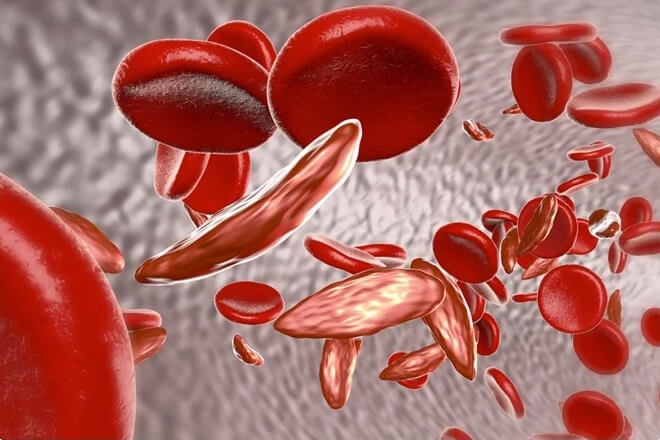Sickle Cell Anaemia is a genetic blood disorder that affects the shape and function of red blood cells. In this condition, some red blood cells, which are normally round and flexible, become crescent-shaped (sickle-shaped). These misshapen cells:
- Clump together and block blood flow in small vessels.
- Break down faster, leading to anaemia (low red blood cell count).
- It is a lifelong condition that often requires ongoing management to prevent complications.
Causes of Sickle Cell Anemia
Genetic Mutation
- The disorder is caused by a mutation in the HBB gene, which affects haemoglobin (the protein in red blood cells that carries oxygen).
- A child inherits the disease if both parents carry the defective gene (Sickle Cell Trait).
Haemoglobin S
People with this condition have abnormal haemoglobin called haemoglobin S, which causes red blood cells to become rigid and sickle-shaped.
Symptoms of Sickle Cell Anemia
Symptoms vary but often include:
Anemia
- Fatigue or weakness due to a lack of healthy red blood cells.
Pain Episodes (Vaso-Occlusive Crisis)
- Periodic pain in the chest, joints, abdomen, or bones due to blocked blood flow.
Swelling
- Painful swelling in the hands and feet due to blocked blood flow.
Frequent Infections
- The spleen may be damaged, reducing the body’s ability to fight infections.
Delayed Growth or Puberty
- Due to anaemia and reduced oxygen supply to tissues.
Vision Problems
- Blocked blood vessels in the eyes can cause vision issues.
Complications of Sickle Cell Anaemia
If untreated, the condition can lead to:
- Stroke: Caused by blocked blood flow to the brain.
- Acute Chest Syndrome: Severe chest pain, fever, and difficulty breathing due to blocked blood vessels in the lungs.
- Organ Damage: Sickle cells can restrict blood flow, damaging organs like the kidneys, liver, or spleen.
- Leg Ulcers: Open sores due to poor blood flow.
- Gallstones: Caused by the breakdown of red blood cells, increasing bilirubin levels.
Ayurvedic Perspective on Sickle Cell Anemia
In Ayurveda, Sickle Cell Anemia can be related to Pandu Roga (a condition similar to anemia) and Rakta Dhatu Dushti (disorders of the blood tissue).
Pathogenesis
- Vata Dosha imbalance is responsible for the rigidity and irregular shape of red blood cells.
- Pitta Dosha imbalance contributes to inflammation and damage to tissues
- Kapha Dosha imbalance affects the immune system, leading to recurrent infections.
- Ojas depletion (reduced vitality) results in fatigue and poor immunity.
Ayurvedic Treatment for Sickle Cell Anaemia
The treatment focuses on:
- Balancing Doshas.
- Enhancing Blood Formation (Rakta Dhatu Poshana).
- Improving Immunity (Ojas).
- Preventing Complications.
Panchakarma Therapies
- Virechana (Purgation Therapy): Clears toxins and balances Pitta.
- Raktamokshana (Bloodletting): May be beneficial in reducing blood viscosity (used cautiously).
- Basti (Medicated Enema): Nourishes tissues and balances Vata.
Dietary Recommendations
- Include iron-rich foods like spinach, pomegranate, dates, and jaggery (in moderation).
- Use herbs like cumin, coriander, and fennel to support digestion and blood formation.
- Avoid processed, fried, and overly spicy foods that aggravate Pitta.
- Drink herbal teas like ginger or tulsi tea to boost immunity.
Lifestyle Practices
- Avoid dehydration by drinking warm water or herbal teas.
- Avoid overexertion and cold exposure, which can trigger pain episodes.
- Practice Pranayama (breathing exercises) to improve oxygenation and manage stress.
- Engage in light yoga for circulation, avoiding strenuous activities.
Rejuvenation Therapy (Rasayana)
- Chyawanprash: Nourishes blood and boosts immunity.
- Kushmanda Rasayana (Ash Gourd Tonic): Strengthens tissues and prevents fatigue.
- Brahmi Ghrita: Enhances mental and physical stamina.
Sickle Cell Anaemia is a serious condition requiring modern medical care for emergencies, but Ayurvedic treatments can complement this by supporting blood health, managing symptoms, and improving quality of life. A holistic approach, including herbs, diet, and lifestyle modifications, can help reduce the frequency of pain crises and prevent complications over time.



